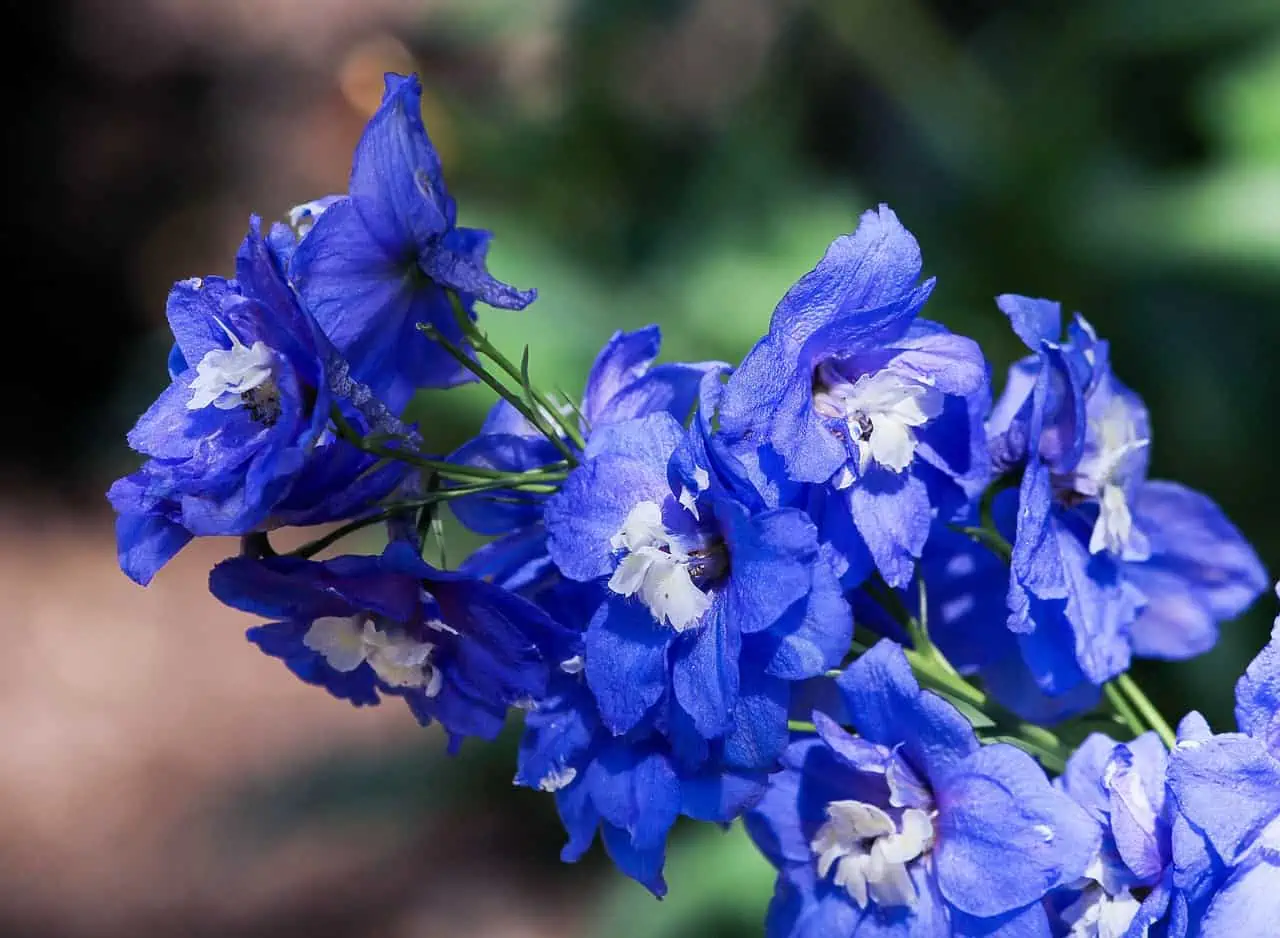
Larkspur flower, scientifically known as Delphinium, are tall, elegant plants that belong to the buttercup family. Native to the Northern Hemisphere, they are recognized for their vibrant and showy blooms. Larkspur flowers come in a range of colors, including shades of blue, purple, pink, and white.
They have a distinctive shape, with a series of petals called sepals that form a spur-like structure at the back of the flower. These flowers are a popular choice for gardens and floral arrangements, thanks to their beauty and long-lasting displays.
What are Larkspur Flowers?
Larkspur flowers are known for their tall and slender stalks, which can grow up to six feet in height. The flowers themselves are typically clustered at the top of the stalks, forming a dense and colorful display.
Each bloom consists of a collection of sepals, which give the flower its unique shape. The sepals can be either single or double, depending on the variety of larkspur. These flowers bloom during the summer months and can be found in gardens, meadows, and wildflower fields.
What does a larkspur flower symbolize?
The larkspur flower meaning have various symbolic, including love, positivity.
Physical Characteristics
- Larkspur flower appearance and size
Known for their tall and elegant stalks, growing up to six feet in height. At the top of these stalks, clusters of vibrant and showy blooms can be found.
Each bloom consists of sepals, which form a unique spur-like structure at the back of the flower. The sepals can be single or double, depending on the larkspur variety. These flowers have a distinctive shape and are recognized for their graceful and slender appearance.
- Varieties and colors
Can come in a range of colors, including shades of blue, purple, pink, and white. These colorful blooms add a touch of beauty and vibrancy to gardens and floral arrangements.
The variety of colors available make larkspur flowers versatile and suitable for various occasions and settings. Whether it’s a romantic bouquet or a garden filled with vibrant hues, larkspur flowers offer a wide array of choices to suit any aesthetic preference.
- Growth and Cultivation
It can thrive in cool climates and require full sun to partial shade for optimal growth. They prefer well-drained soil that is rich in organic matter.
Larkspurs are known to be hardy and can withstand cold temperatures, making them suitable for regions with mild winters. Adequate spacing between plants is necessary to allow air circulation and prevent diseases.
What does a larkspur flower look like?
Larkspur flowers are distinguished by their tall and elegant stalks, reaching heights of up to six feet. At the pinnacle of these stalks, clusters of vibrant and showy blooms can be observed.

Each bloom consists of sepals, which form a unique spur-like structure at the back of the flower. The sepals can be single or double, depending on the larkspur variety. These flowers are distinguished by their distinctive shape and are acknowledged for their graceful and slender appearance.
- Different varieties and color
Come in a range of colors, including shades of blue, purple, pink, and white. These colorful blooms add a touch of beauty and vibrancy to gardens and floral arrangements.
The variety of colors available make larkspur flowers versatile and suitable for various occasions and settings. Whether it’s a romantic bouquet or a garden filled with vibrant hues, larkspur flowers offer a wide array of choices to suit any aesthetic preference.
- The shape and structure
Larkspur blooms have a unique shape and structure that sets them apart from other flowers. The sepals, forming the distinctive spur-like structure at the back of the flower, give larkspurs a characteristic appearance.
This elongated spur gives the bloom a graceful and slender look, adding to their overall appeal. The sepals protect the petals and reproductive parts of the flower and play a role in attracting pollinators.
- Comparison to other similar flowers
They are frequently compared to delphiniums due to their similar appearance. Both flowers feature tall stalks and clustered blooms in various colors.
However, larkspurs are generally smaller and more delicate compared to delphiniums. Larkspurs also have unique spur-like structures at the back of their blooms, which are absent in delphiniums. While both flowers offer beauty and grace, larkspurs have their own distinct charm.
How to identify?
Look for their tall stalks and clusters of vibrant blooms. The distinctive spur-like structure at the back of the flower is a key identifier.
Pay attention to the variations in color, as larkspurs come in different shades such as blue, purple, pink, and white. Familiarize yourself with the unique appearance and shape of larkspur blooms to recognize them accurately.

How to plant and care for Larkspur flowers?
To plant larkspur flowers, sow the seeds directly into the garden bed in early spring or late fall. Choose a well-drained area with full sun to partial shade.
Prepare the soil by removing any weeds and loosening it with a garden fork. Scatter the seeds evenly and cover them with a thin layer of soil. Water the area gently to keep the soil moist, but avoid over watering. Once the seeds germinate, thin out the plants to provide adequate space for growth.
Caring for larkspur flowers involves regular watering to keep the soil moist, especially during dry periods. Apply a balanced fertilizer once a month to promote healthy growth.
Deadhead the spent blooms to encourage continuous flowering. In regions with hot summers, providing some shade during the hottest part of the day can help prevent wilting. By following these care tips, you can enjoy a beautiful display of larkspur flowers in your garden.
Larkspur Flowers in Gardens and Bouquets
They are popular choice for garden designs due to their tall and elegant stalks, vibrant clusters of blooms, and a wide range of colors. Their graceful and slender appearance adds beauty and charm to any garden. Whether in beds, borders, or as cut flowers, larkspurs bring a touch of elegance and vibrancy to outdoor spaces.
- Floral arrangements and bouquets
It also make stunning additions to floral arrangements and bouquets. Their unique shape, with the distinctive spur-like structure at the back of the blooms, adds an interesting element to any arrangement.
The variety of colors available, such as shades of blue, purple, pink, and white, allows for a wide range of creative possibilities. Larkspurs bring a sense of beauty and sophistication to any floral design, making them a favorite among florists and flower enthusiasts alike.
- Folklore and Traditions
These flowers possess a rich history and cultural significance that enhances their charm and allure. They are honored and celebrated in diverse folklore and traditions across various cultures.
In Western folklore, people commonly linked larkspur flowers with protection. There was a belief that surrounding a house with larkspurs or wearing them as a charm could deter evil spirits and attract good luck. In certain cultures, larkspur flowers played a role in rituals and ceremonies, symbolizing purity and tranquility.
This flower also hold a place in Greek mythology. According to the legend, the larkspur emerged from the tears of the Greek god, Apollo, when he wept over the death of his friend, Hyacinth. The flower’s said to have originated from the blood of Hyacinth and was dedicated to Apollo.
The vibrant and diverse colors of larkspur flowers have different symbolic meanings. For instance, the blue larkspur represents serenity and calmness, while purple signifies dignity and admiration. Pink larkspurs symbolize fickleness, while white larkspurs are linked with purity and innocence.
Throughout history, larkspur flowers have made a lasting impact on human culture and persist in garnering admiration for their beauty and symbolic significance in various traditions and folklore.
Are larkspur flowers poisonous?
When it comes to larkspur flowers, it’s crucial to exercise caution. While these beautiful blooms add a touch of elegance to any garden, they can be toxic if ingested. Larkspur plants contain alkaloids, which are natural chemical compounds that can be harmful to humans and animals.
The toxicity of larkspur flowers can fluctuate based on the species and the growing conditions. It’s essential to keep children and pets away from these plants to avoid any accidental ingestion. If you suspect that someone has consumed larkspur flowers, it’s advisable to seek medical attention immediately.
However, it’s important to note that larkspur flowers are not typically dangerous if handled properly. Simply avoiding ingestion and taking the necessary precautions can ensure that you can enjoy the beauty of these flowers without any harm.
Prioritize safety when dealing with larkspur flowers by keeping them out of reach of children and pets, and educating yourself about potential risks. By understanding the potential dangers, you can fully appreciate the beauty of larkspur flowers while keeping everyone safe.
What is larkspur plant used for?
Larkspur plants, known for their vibrant and delicate flower spikes, widely serve decorative purposes. People commonly use these flowers in gardens, floral arrangements, and include them as cut flowers in bouquets. Their tall and elegant stalks, coupled with their range of colors, make them a popular choice for adding visual appeal to any space.
Beyond their ornamental appeal, larkspur plants have found application in traditional medicine. There is a belief that specific parts of the plant harbor therapeutic properties,
People have utilized extracts from the larkspur plant to address ailments like digestive disorders, respiratory issues, and even as a sedative. However, it’s crucial to emphasize that the plant contains toxic substances. Hence, caution should be exercised when using it for medicinal purposes.
Overall, the larkspur plant offers both aesthetic beauty and potential health benefits. Whether adorning a garden or used as a natural remedy, this flower has certainly found its place in various aspects of human life.


